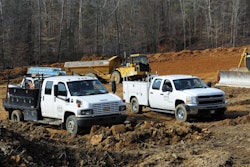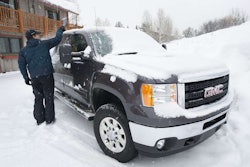Cool MPG Gains
 Snow Performance MPG-MAX water/methanol injection.
Snow Performance MPG-MAX water/methanol injection.
By Tim Walton
Don’t tell James, the owner of our test truck, but we did enough hill climbs with his Cummins powered Dodge RAM and 44-foot trailer to get the brakes smoking. We were testing the EGT handling capabilities of the MPG-MAX water/methanol injection system by Snow Performance. The system did a great job of keeping the EGTs down. Now we need to upgrade the trailer brake controller before moving on to mileage testing.
If you’re thinking water and diesel don’t mix, I get that. In fact, water separators and fuel contamination has been part of our vocabulary for a long time. But the idea of including water in the diesel goes all the way back to Rudolf Diesel, who recognized the benefits of water injection in diesel combustion as a way to get more useable work out of the heat of combustion.
“Just as turbocharging is a way to scavenge normally wasted energy, water injection is used for the steam effect in combustion where additional torque is produced as the water droplets go from liquid to vapor,” says Matt Snow.
In addition to this steam effect, methanol itself is fuel, so it burns in the process. The injections also contribute to combustion conditioning, resulting in smaller diesel droplets, greater surface area and more efficient fuel burn during the combustion event.
 The methanol/water injection kit comes with the controller and all the tubing, nozzles and needed hardware to install.
The methanol/water injection kit comes with the controller and all the tubing, nozzles and needed hardware to install.
The advanced design of the MPG-MAX unit, which includes three injection nozzles, uses significantly more water (or water/methanol mix) than systems designed only for power delivery. The difference is that the Snow system uses a smaller nozzle to delivering a mist of the cooling liquid at a wider range of boost levels. This means the larger water tank we installed in the bed is a must. Other kits can get away with a smaller tank mounted in the engine bay or fenders. Because of this, the install involves a bit more plumbing, but the gains are worth it.
Because our test pickup is scheduled for a high performance fuel lift pump mounted on the frame rails, we found a spot for the Snow pump under the pickup bed. If you’re going to install a variety of modifications to improve your pickup it’s important to take into account future mods so you don’t have to relocate or reroute later.
You can use Boost Juice from Snow Performance for the methanol component of the mix, which Snow recommends for their warranty. You can also buy methanol and dilute it yourself. Snow recommends not doing more than a 50/50 mix which still provides a large power and torque gain without being too volatile of a mixture. Another popular source of methanol is a winter mix of windshield washer fluid that contains 33 percent methanol; however it also includes some detergents and dyes which the Snow Boost Juice doesn’t include.
Once we had the system all hooked up we put it to work towing a triple axle 44-foot trailer that is one of a few trailers the pickup regularly tows. Because this truck lives in a valley, any direction you go, you’re going to be pulling a mountain pass.
We did some testing on a hill that the owner normally pulls and has to back off and downshift to keep the EGTs under 1,300 degrees F. With the injection setup in tow mode, we never saw EGTs much over 1,100 degrees. While EGT is one of the aspects that should be watched when towing a heavy load (others include oil and coolant temperatures), it tends to be one of the first limitations your pickup is going to run into when pulling a grade.
After getting the settings dialed in for the injection timing and percentage, everything was running smoothly. We’re expecting the best MPG gains to be seen towing the loaded trailer. The MPG-MAX also gives you peace of mind by minimizing the risk of melting the turbocharger with high EGTs while towing.
If you run only water you should see a 6 percent gain in mpg – which is about 1 mpg gain over stock. We haven’t tested it long enough to figure out exactly what it’s going to get on this rig but we’re having the owner report back to us his mileage.








